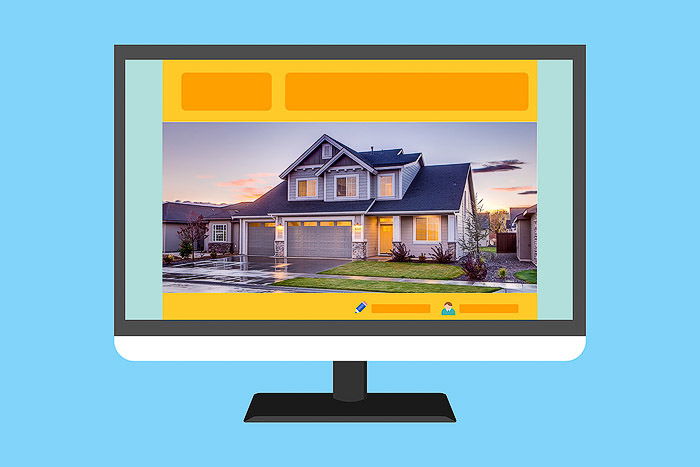10 Real Estate Photography Marketing Tips for More Customers
Real estate photography is a business first and photography second. Marketing is essential for success in this photography niche.
But where do you even start? And what are the best marketing techniques for real estate photography?
In this article, we’ll outline some real estate photography marketing tips to get you going.

1. Real Estate Photography Marketing: Ask for Referrals to Boost Your Business
Word of mouth should still be at the front of all your marketing efforts. Many photography businesses exist only because of word of mouth.
You can start with friends and family. Ask them to refer you to some real estate agents they know. Ask friends to put your visiting cards or flyers on their office message boards. Sometimes only mentioning your real estate photography in conversations can get the ball rolling.
You’ve got to be well-prepared for the word of mouth to work, though! Have an online presence ready, shiny and functioning. You need a great website with portfolio, contact form, reviews, and testimonials.
Of course, you need to produce great photos for this method to bring you customers. Bad real estate photos will repel all the newcomers.

2. Create Targeted Campaigns to Attract Audience
Successful photographers are often experts at promoting themselves across various social media platforms. Unless you already have a large following, your free posts have a low chance of getting noticed. The only possibility is that it’ll work in the same way as word of mouth: if someone you know reshares them.
The better approach is to pay for ads. But there’s a trap! If you set up your Facebook marketing campaign wrong, it’ll eat up a lot of money without bringing any results.
Study your audience, create a targeted campaign. Remember that these ads should have a very attractive front cover. Use something spectacular, like a house front at twilight (they are the biggest sellers). Look up and examine a bunch of profiles so that you can rule out your ads criteria.
Another excellent approach to social media is to create something unusual or viral. No one is going to repost your real estate photos. But they could repost an amazing behind-the-scenes video or beautiful drone footage.
Before and after photos could also go viral. Make sure to ask consent from the agent/owner to use their pictures. Or you could make a few crooked snaps with your phone and compare them to your final shots.

3. Network to Build Valuable Relations
Networking was an eye-opener for me. Here is the deal. ALL business owners struggle to get clients and build relations with other businesses. You are not alone.
Business meetings are happening all over the place, every week, in every town. You only need to find and attend them. Have your business cards and flyers ready.
You’ll find other people trying to grow their business as well. They are already open-minded and prepared to cooperate. Be friendly and learn to present yourself nicely and briefly.
You may want to contact the organisers to see if there are any real estate agents or brokers attending. Step up and talk to them. They’ve come to find new opportunities after all.
Often, these meetings happen early in the morning or later in the afternoon. Start your search on meetup.com or bni.com. All of these meetings are free to attend. Often you need to RSVP.

4. Hand Out Flyers to Find Prospective Clients
You need a quick and easy way to present yourself. An excellent way to achieve it is to print flyers and brochures and deliver them to prospective clients.
Printing is easy, and you can either do it yourself or hire a designer.
Here are a few ways to get eyes on your flyers and brochures once you have them:
- Bring them to offices. You need to be a charismatic person to get past the gatekeeper or have a super eye-catching flyer.
- Put it in their post box. They put their flyers in yours all the time anyway, don’t they?
- Visit open houses and have a quick chat with the agent. If it’s too crowded, leave a bunch of your printed materials on the tabletop.

5. Present Your Work in Person to Convince Your Clients
I haven’t done this, but many real estate photographers say it’s the best way to get a lot of clients. You must be good at speaking in public and creating convincing presentations.
The strategy is the same. You find an agent at an open house or go directly to their office. Ask if you could make a presentation along with some fantastic first-timer offers that no sane person could refuse.
Your displays should be as attractive as possible. And of course, you should have a great offer to mention.
The overall time they give you at their daily meeting is 5-15 minutes at best. Think ahead!
You must bring some printed materials to leave with them. And you could bring your laptop to show some links/graphs/portfolio/videos.

6. Send Personalised Emails to Get Noticed
If you build a well-targeted email marketing campaign, you can reach some clients directly.
Collect emails from real estate sites. Start with something like 50 personalised crafted emails. Do not send general faceless junk, make it feel like you are sending directly to them.
Use the agent’s name, mention one listing they have that could use better photos, tell them you are local to their area, etc.
When collecting emails from the sites, look for those agents who don’t have great photos or where your photos would naturally stand out as better.
You may also offer a free first shoot if you struggle to fill your portfolio. But don’t fall into the freebies trap as some agents could try to take advantage of you.
You don’t need to provide free sessions for everyone (or anyone) if you already have a portfolio.

7. Optimize Your Website to Gain Traffic
Photography business SEO is a vast topic. And it deserves at least a long-form article or maybe even a course. SEO stands for Search Engine Optimization. This is how we try to rank high in Google and other search engines.
Why is SEO important? It can become a single source of leads. The bad news is that SEO is hard to master. It can take months, if not years, to build an authority website that ranks well for competitive keywords.
SEO for photographers is no different from other businesses, it basically involves two steps:
- Optimize your website. A useful guide is here: https://backlinko.com/on-page-seo.
- Build backlinks
Easy, huh?
While optimisation is doable within days or weeks, link-building takes ages. To rank high, you don’t need spammy backlinks from shady sites – it doesn’t work anymore. You need links from reputable sites and excellent content.
Some quick ways to start out and build backlinks:
- Add a bunch of local citations. You can use brightlocal.com to find the sites to add your local listing. Sites like Yelp, Google Business, Houzz and many others.
- Send your content to public sites like BoredPanda.com and hope it gets re-shared.
- Track how people use your photos using Pixsy.com and ask them to credit you.
Linkbuilding is an art. If you have a budget, delegate it to professionals. Make sure to avoid cheap packages. Google will recognise them, and they could result in a penalty.

8. Check Local Directories to Study Your Competition
Like I have mentioned above, you need a lot of local citations. But there is more. You should also look up local directories and join them.
A good directory is client-oriented, and potential customers go there to find a real estate photographer. A good example is Houzz.com, which has local subsites all over the world.
Study your competition there, learn their ranking rules and try to make it to the top.
It’s OK to try a paid membership for a couple of months and see if it works. A single client will cover your membership costs for at least 3-5 months.
Every single such directory has different ranking rules. And to succeed, you should adjust your profile to be on top. Some sites favour a vast portfolio, others prefer lots of reviews. Some pay attention to what you left out from your profile.
Read their terms and FAQs and start from there. Don’t hesitate to contact support and ask questions. Business is business, after all.

9. Make Your Cold Calls Casual for a Better Response
Cold calls are evil. We all hate telemarketers that keep calling. It is essential to make it right and to have a pro photographer feel instead of being another spammer.
Choose Your Audience
- Be picky! Go to your local real estate listings website and try to find agents who have at least a dozen listings per year.
- It’s a gem if they don’t use a pro photographer yet. You can tell this from their past listings.
- Try to find agents who have their current listing for at least a month.
With all these criteria met, you have an excellent starting point. What’s next?
Make the Call
Call people without sounding overly official. Say something like “Hey, it seems your listing has been online for a while now. I thought maybe you would consider bringing a few professional photos and seeing if it works better for the house? It could help you strike a deal and close it finally. I’m a local photographer and could help you out.”
If you sound casual yet convincing, you have better chances of finding consensus.

10. Create a Property Listing on Your Site for More Traffic
Displaying properties on your site should be part of your real estate marketing. I don’t mean adding a bunch of new photos to the portfolio gallery. Instead, create a whole listing.
Create a slideshow, insert a video, add an agent’s profile and a map. Make it look like a serious real estate listing.
Why? First, it could bring you additional backlinks. Second, the agent will drive traffic to the listing. Third, anyone browsing the listing will see your portfolio, contact form and could become the next client.
The only thing here is that you will either need to delete the listing after it has been sold or mark it as sold and archive. The latter is much better, of course. It adds to your portfolio and shows how many listings were sold using your brilliant photos.

Conclusion
I’ve listed some real estate photography marketing ideas for you to try out. Of course, the final strategy should consider the unique local conditions, which could be different for every area.
I can recommend reading business books, talking to people and looking around to figure out your own ideas and strategies. There are many excellent online guides as well to start building a photography business.
But the primary factor is the quality of your real estate photos. Your work should stand out and speak for itself.
Want to learn more about boosting your social media presence as a photographer? Check out our ebook Social Success Strategies next!




